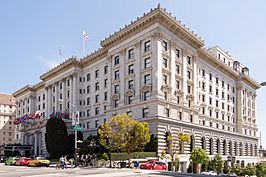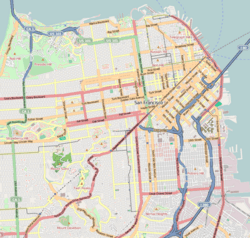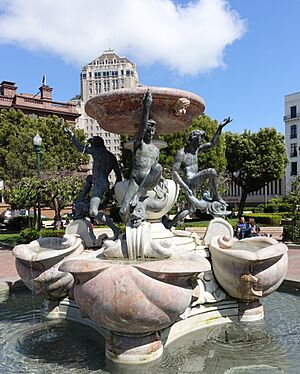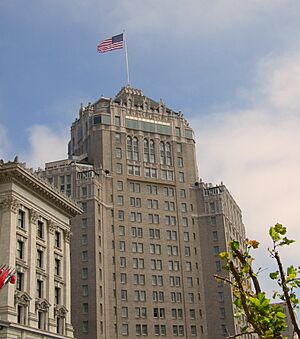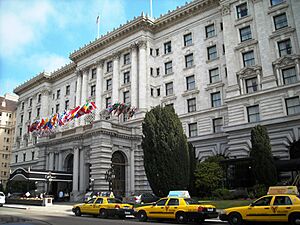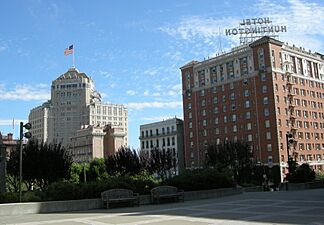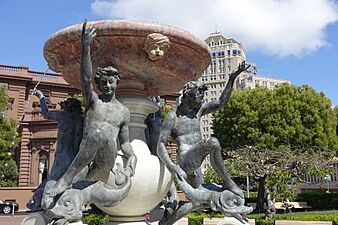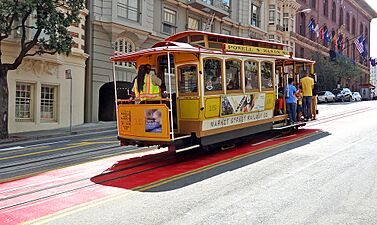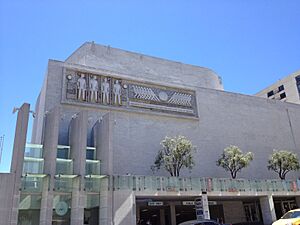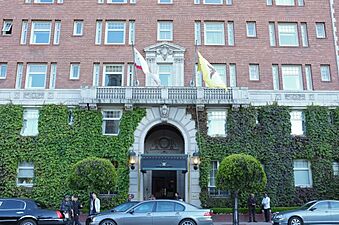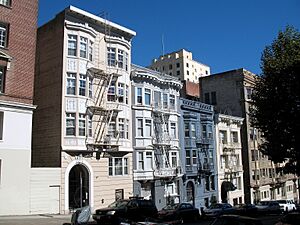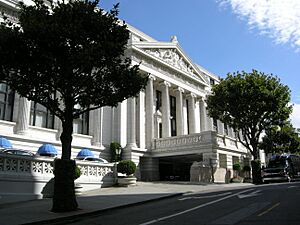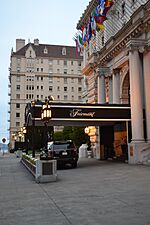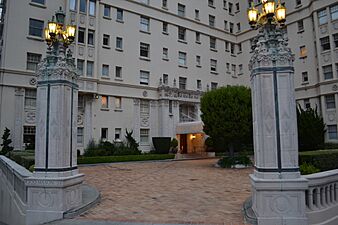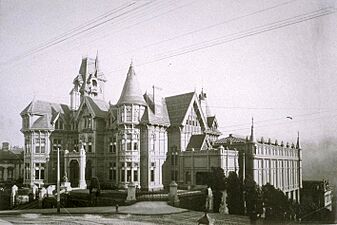Nob Hill, San Francisco facts for kids
Quick facts for kids
Nob Hill
|
|
|---|---|
|
Counter-clockwise: Fairmont San Francisco; Powell Street; Huntington Park; Grace Cathedral
|
|
| Country | |
| State | |
| City-county | San Francisco |
| Area | |
| • Total | 0.313 sq mi (0.81 km2) |
| Population | |
| • Total | 20,388 |
| • Density | 65,140/sq mi (25,150/km2) |
| Time zone | UTC−8 (Pacific) |
| • Summer (DST) | UTC−7 (PDT) |
| ZIP codes |
94108, 94109, 94133
|
| Area codes | 415/628 |
Nob Hill is a famous neighborhood in San Francisco, California, United States. It's known for its fancy luxury hotels and old, grand mansions. For a long time, it has been a place where wealthy families in San Francisco lived. Nob Hill is one of the most expensive places to live in the United States. It has many Michelin-starred restaurants, unique shops, cultural institutions, art galleries, and historic landmarks. The neighborhood is named after one of San Francisco's original "Seven Hills". It also includes an area called the Lower Nob Hill Apartment Hotel District.
Contents
Where is Nob Hill?
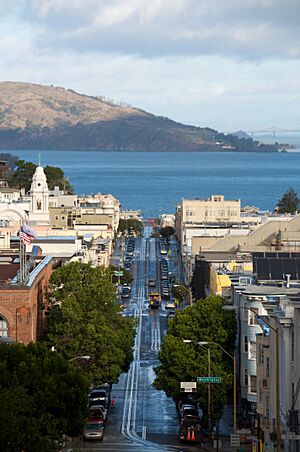
The highest point of Nob Hill is near the crossing of Jones and Sacramento Streets.
Nob Hill is surrounded by other interesting neighborhoods:
- To the north is Russian Hill.
- To the west is Pacific Heights.
- To the south are the Union Square shopping area and the Civic Center.
- To the east are Chinatown and the Financial District.
- To the northeast are North Beach and Telegraph Hill.
The Polk Gulch area is on the western edge of Nob Hill and Russian Hill. The southern part of Nob Hill is known as Lower Nob Hill. There's also an area called the Tendernob, which is between Nob Hill and the Tenderloin neighborhood.
The Story of Nob Hill
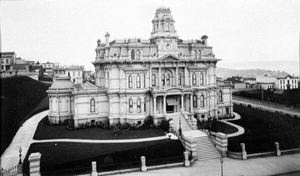
Before the 1850s, this area was called California Hill. It was named after California Street, which goes up its steep eastern side. Later, it was renamed Nob Hill. This new name came from the "Nobs," who were the four powerful leaders of the Central Pacific Railroad. They built their huge mansions on this hill.
In the late 1800s, San Francisco grew very quickly. Because of its amazing views and central spot, Nob Hill became a special place for rich and famous people on the West Coast. They built very large homes here. Famous business leaders like Leland Stanford, who started Stanford University, were among these early residents. These wealthy men were sometimes called nabobs. This word was shortened to nob, which is likely how the area got its name.
The 1906 Earthquake and Fire
In 1906, a big earthquake and fire destroyed most of the neighborhood. Only the strong granite walls around the mansions of Stanford, Crocker, Huntington, and Hopkins remained. You can still see these walls today. They even have black marks from the intense fires that burned after the earthquake.
The Fairmont Hotel, which had just been finished, was also badly damaged by the fires. The mansion of wealthy businessman James Clair Flood was also gutted. Both buildings had stone outsides that survived the fires. They were later cleaned up and fixed. The Fairmont Hotel is still open today. The Flood Mansion is now the home of the exclusive Pacific-Union Club.
Even after the earthquake, Nob Hill stayed a wealthy area. However, all the mansion owners moved or rebuilt their homes somewhere else. Some built new mansions in other parts of San Francisco, like Pacific Heights and Cow Hollow. In place of the destroyed mansions, new, fancy hotels were built. These include the Mark Hopkins, Huntington, and Stanford Court hotels.
What Makes Nob Hill Special?
Nob Hill is a rich area. Many wealthy families live here, along with many young professionals. There's also a growing Chinese immigrant population from nearby Chinatown.
Famous Hotels
Four of San Francisco's most famous and expensive hotels are on Nob Hill, along California Street:
- The Mark Hopkins Hotel
- The Stanford Court
- The Huntington Hotel
- The Fairmont Hotel
These hotels were named after important San Francisco business leaders. These leaders included Mark Hopkins, Leland Stanford, and Collis Potter Huntington. They were three of the "Big Four" who helped build the Central Pacific Railroad. The Fairmont Hotel was named after James Graham Fair.
Other Important Buildings
Across from the Fairmont Hotel and the Pacific Union Club is Grace Cathedral. It is one of the largest churches in the city.
The main building for the Grand Lodge of California is the SF Masonic Auditorium.
In Lower Nob Hill, the Academy of Art University owns several buildings. These are used for student housing and classes.
Also in Lower Nob Hill, on Bush Street, you can find the Memorial Home of Fire Chief Dennis T. Sullivan. There are also two sister hotels, the White Swan Inn and Petite Auberge.
Parks to Explore
Nob Hill has many old and well-kept parks. The most well-known park in the neighborhood is Huntington Park. It takes up a whole city block. It is bordered by Sacramento Street, Taylor Street, California Street, and Cushman Street.
Huntington Park used to be the site of a mansion owned by Collis Potter Huntington, one of the Central Pacific Railroad leaders. His mansion was destroyed in the 1906 earthquake and fire. In 1915, Huntington's widow gave the land to the city to create a park. Huntington Park has a playground for kids, beautiful landscaping, and several fountains.
Washington & Hyde Mini Park is a smaller park. It is located between two apartment buildings on Washington Street, between Hyde Street and Leavenworth Street. This mini park also has a playground for children and nice plants.
Pictures of Nob Hill
-
The Mark Hopkins Hotel and Huntington Hotel
-
San Francisco cable car on Powell Street
-
Mark Hopkins mansion.
See also
 In Spanish: Nob Hill (San Francisco) para niños
In Spanish: Nob Hill (San Francisco) para niños


